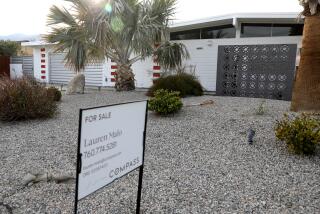Helping women to profit
- Share via
IMAGINE you’re a beginning real estate investor and you meet someone who has successfully invested in all kinds of properties around the United States for almost 30 years. She becomes your mentor -- sharing her experiences, introducing you to helpful professionals, filling you in on what to expect and steering you away from pitfalls.
That’s the role Lisa Moren Bromma ably performs in “Wise Women Invest in Real Estate,” a thorough guide to buying, managing and selling properties.
Bromma is both enthusiastic and realistic about the money that can be made in today’s less-than-exuberant real estate market. She’s particularly upbeat about the prospects for women, despite the fact that she rarely runs into women who have been successful at what she does.
Her own first purchase was as a single mother of two in 1978. With a new job and no credit history, she bought a $39,000 Florida home with $1,000 down and 12.5% owner financing; five years later, she sold it for $43,900 and was on her way. Today, Bromma has a portfolio valued in the millions and leads workshops nationally.
The author says women are good listeners -- which makes them great negotiators -- and are detail-oriented and good at doing research, qualities that pay off in real estate.
So why don’t more women invest? She chalks it up to fear. After making her pitch to women to put aside their worries, Bromma launches into the practical advice that will help them get started. All of the investors and professionals she quotes are women, lending a subtle “you can do it too” feeling to the book.
But her advice is mostly gender-neutral. Anyone could benefit from her help, and she offers it generously, drawing on accepted wisdom and her own experiences.
The book starts with chapters on organizing financials and deciding what kinds of properties to buy. She writes in detail about finding properties, rehabbing them, working with agents, negotiating with sellers, managing rentals, choosing financing methods, selling and staging a property, and buying in a down market. The ordering of chapters seems odd, but each stands alone, so it’s not disorienting.
Written after the market started to cool, her advice takes current realities into account. She emphasizes that instead of looking to make money when they sell, investors should look for good deals on the front end and not buy for emotional reasons.
Bromma acknowledges that real estate prices vary widely across the U.S., as does the cost of renovations, something investors need to watch out for. She gives the example of one investor, Beth, who was very successful in Alabama doing cosmetic fix-ups of properties. When Beth moved to Colorado, however, higher costs there cut into her profit, and she only broke even on properties she improved.
Though Bromma is bullish about real estate as a wealth-builder, she urges readers to do their due diligence to avoid expensive mistakes. Check references -- whether of a property manager, contractor or tenant -- get everything in writing, buy the necessary insurance, walk away when you have to.
She’s adamant that you don’t have to win at someone else’s expense. When she’s looking at homes, Bromma asks sellers open-ended questions to find out their needs -- are they selling to downsize or because of illness or divorce? She then makes an offer that takes those needs and her own into account.
In one case, this meant allowing a seller to live rent-free in her house for six weeks after Bromma bought it -- for 15% less than the asking price. The woman was moving to Argentina to care for an ailing parent, and Bromma’s flexibility in giving her time to get organized sealed the deal.
“There has been much recent speculation regarding what the future of real estate will be,” Bromma writes. “Ignore it. You need to look at each deal and see whether that deal is going to work for you.”
*
More to Read
Inside the business of entertainment
The Wide Shot brings you news, analysis and insights on everything from streaming wars to production — and what it all means for the future.
You may occasionally receive promotional content from the Los Angeles Times.











